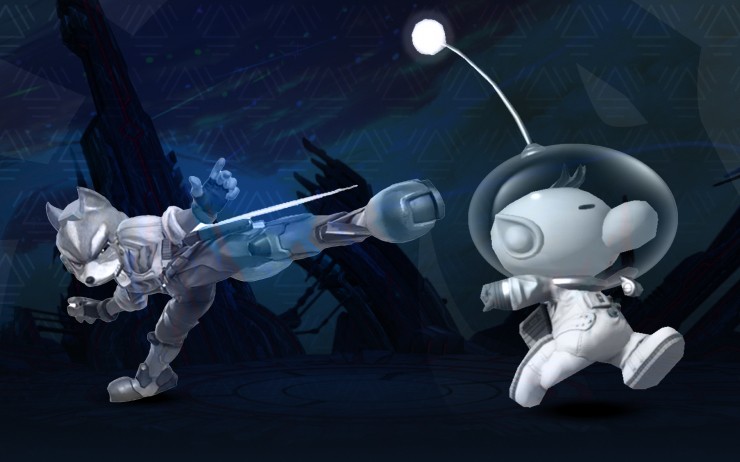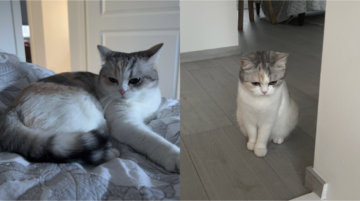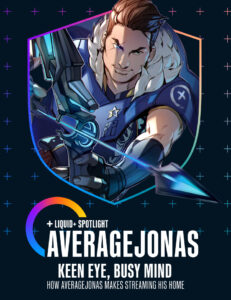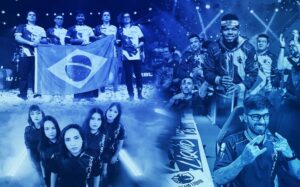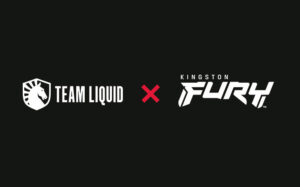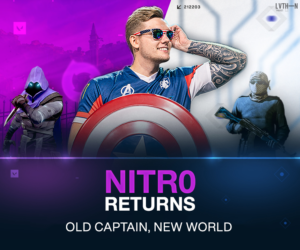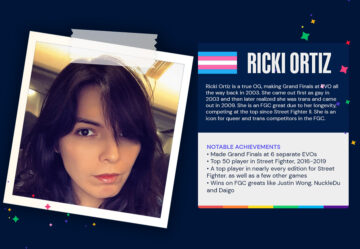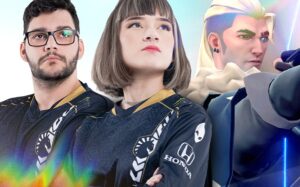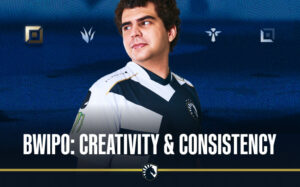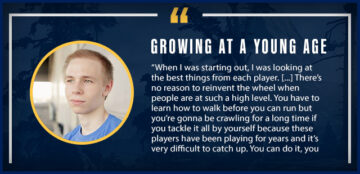“Olimar is… He’s weird.” The way Dabuz says it, he sounds a little lost.
Known for an intellectual, calculating approach to Smash, Dabuz is at his most contemplative when talking about Olimar. It is, after all, the character that brought him into the pro scene back in the Brawl days. He’d fallen in love with Pikmin even before then.
“He is a lightweight grappler in terms of how he plays,” Dabuz says after taking a beat to collect his thoughts. “Sure, he dies super early but he literally has a good grab game, has a really good up-close game, he hits hard. […] He forces people to guess so much.”
Later in the interview, Dabuz will add more words to the archetype-salad that is Olimar. “We’re a grappler, zoner, swordie, hybrid. Cause our aerials are these massive sword hitboxes. Disjointed, fast, safe, [leads to] combos, you name it.”
A lightweight grappler, zoner, swordie, mix-up, mid-range hybrid character. With an added resource management mechanism because – sure. Why not? In the wider world of fighting games, very few characters could justify all those words.
But Ultimate itself is a unique entry into the genre. And by being odd, Olimar gets at how Nintendo wants a Smash character to be.
Not every character should be weird or complex like Olimar, but every character should be a reflection of their origin point. In Ultimate especially, Nintendo prioritized recreating the feel of the character’s original game within their kit. They capture that feeling so well that you could consider a fault in design. Something a proper fighting game might not wanna prioritize.
Steve, Terry, Sephiroth, Min Min, Joker, Pythra – Nintendo didn’t spare a second thought on how irritating these recreations might be to fight. You might feel like dying when Steve builds a literal “L” over your recovery path. But so what? Nintendo is more concerned that Steve feels like Minecraft in a platform fighter. (And like it or leave it, this philosophy has a lot of positive effects and is a big part of why Smash dominates the platform fighting world.) ¹
[embedded content]
(“So, what do you think? What exactly did we just watch?” Sakurai asks two questions that we will now ask ourselves after every set with a Steve in it. He goes on to explain how much effort it took to faithfully recreate Minecraft in Smash.)
So Olimar isn’t a weird character because Nintendo wanted a wildcard on the roster. Olimar is a weird character because Pikmin is a weird game all the way down to the feeling. The GameCube original leans on time and resource management and hands you a completely fragile main character who is outmatched and outsized by everything he runs into. One of Nintendo’s most bizarre products, it flouts what video games are traditionally about. There’s no power fantasy here, just survival. (And not even the normal adrenaline-filled, horror survival). The controls, the narrative style, the level design, it’s all super weird. And all during a time when the indie market had not fully developed, meaning that games were rarely this bizarre.
You’d be as hard-pressed to slap a clear label on Olimar as a fighter as you would on Pikmin as a game. That’s not a bug, it’s a feature. It’s part of the Nintendo Magic. Part of why a young Dabuz would not only pick Olimar but play him for years to come. Part of why Olimar was busted in Brawl (6 pikmin may have been too faithful a recreation). And now it’s part of why, in Ultimate, Olimar is stranded on a planet of faster and more lethal creatures.
Stranded on Planet Ultimate
After all, that is the whole thing behind Olimar. The guy can do almost nothing without his vegetable vanguard and so in Ultimate, he’s very vulnerable without pikmin. In turn his character is very slow, not very durable, his disadvantage is brutal, and much of his goal is to survive as long as possible, do as much as possible, in a pressure-cooker environment.
“It’s the main reason he’s not a top tier character or even in discussion for being top tier, right?” Dabuz means that of Olimar’s disadvantage. It’s one of the things you’ll hear a lot about from the players and the commentary, right up there with weight. Olimar is in the 6th lightest weight class in the game, which means he dies earlier (making his bad disadvantage even worse).
“It is a huge problem. Straight up, if Olimar was even mid-weight, like Mario weight, he’d be an absurdly strong character,” Dabuz speculates. “You could make an argument for Olimar being borderline top tier just off the theory of ‘What if instead of dying at 50-100, you’re gonna start losing your stock at 90 to 130 on average.”
It might sound like hyperbole but the weight class is brutal for a semi-grappler. In traditional fighting game design, grapplers are slow and do big damage off of somewhat risky openers – as Olimar does. But they have a big health pool that lets them take repeated risks – as Olimar doesn’t. Bowser and DK, especially in Smash 4, are the traditional grapplers of the franchise.
Olimar’s weight is another weird element to his character that probably stems from matching Pikmin design logic over matching fighting game design logic. Given how deliberately fragile he is in his games, the vegan explorer’s vibes would be all off if he could stomach big hits. But to Dabuz, this isn’t even Olimar’s main weakness. Olimar’s biggest trouble is something even more thematic. ²
“His main weakness is losing neutral – that’s it. If you lose neutral then you’re screwed; if you lose the lead vs. a fast character then you’re screwed. That’s solely because, more than weight, you lose that neutral to anything. Even a poke, a safe falling aerial, or a projectile randomly hits you to the ledge. Suddenly it just feels awful.”
Dabuz’s stance is pretty easy to validate through Genesis 8 alone. Light’s Fox was the primary predator, going 6-1 against Dabuz and Myran. In the one game Dabuz won, he got the lead early and held tight. In a game apiece where Myrand and Dabuz nearly mount the comeback, they’re stuffed out when Light finds two low-percentage kills off of hyper-reliable confirms.
[embedded content]
(Dabuz takes a quick stock but Light nearly equalizes by feasting on Olimar’s disadvantage.)
You watch most Olimar games and the character switches between looking broken to hopeless during the set. It’s because the astral carrot farmer’s zoning and swordie elements make him a pain to approach. And when you do approach, fitting to his grappling and mix-up elements, he does so much damage and applies so much pressure.
But when he’s behind, he has to waddle towards a character that’s almost guaranteed to be faster and more agile – and that’s if he’s not giving up stage control to get a better pikmin lineup. If he’s a full stock behind, the pikmin lineup means he doesn’t get to gain position off of the respawn invincibility either. And for Olimar, an Ultimate comeback can be a long march. Those carrots can stack up percent but it can be tricky to get those early ledge trap kills.
“He’s a bit too slow so he has a lot of trouble covering ledge rolls reliably. A lot of times he has to commit a ledge trap, he has to pick an option, guess right to get damage and kills. Even [just] to hold the ledge trap situation.” So, the opponent has a lot of time to look for a haymaker or reversal that will stuff Olimar’s advantage – or kill him outright due to his weight class.
[embedded content]
(an example of Dabuz getting clever in disadvantage)
However, Olimar stays in the high tier in part because his disadvantage state still leaves room to be clever. Mainly in that he’s got whistle – a two-frame super armor option – and some buttons you’ll need to respect – like dair, up smash, jab, or even neutral air.
“If he can make the reads on what the opponent’s looking for he can escape disadvantage state pretty smoothly. He has very, ‘If I guess right, this mix-up’s gonna get me out of disadvantage’ type options. He has mobility-based options, armor-based options that all have to be responded to a bit differently.”
But it’s all still a guess – a game of rock, paper, scissors where you spiral out of control as soon as the opponent learns that you’re a “good ol’ rock” type of player. “Because he has to mix up his disadvantage state and be unpredictable, if the opponent has a good bead on how you’re gonna do that, yeah it’s gonna be suffering.”
[embedded content]
All that feast and famine, that fragility and potency – all of it is thematic. This is how the nickel-sized astronaut is supposed to be. Like, spiritually. He’s an underdog with little hope if he doesn’t have a handful (or a horde) of pikmin. Almost every animal in Pikmin can 1v1 Olimar and most of them can out-brawn an entire veggie army. You only win by being clever, preserving as much as you can, reading attack patterns, and building to a point where it is very hard for the predators to fuck with you.
And if you slip up one time, you’ll really feel it. If that sounds brutal to play as or against – well, Pikmin could be a brutal game.
I remember playing Pikmin when it came out. There’s a little coastline outside of the first area you land in. I’d built up a nice army of pikmin at the end of day 2 or 3 and made good progress on the map. As my pikmin and I marching back to home base for the night, I accidentally swiveled the c-stick and sent 60 little dudes straight into the water to die. I was 8 years old and I still remember hearing the death rattles of all the pikmin echoing together, all the spirits gathering into a clump, as I threw the whole game.
When I watch Dabuz, Myran, or Shuton lose neutral and then the game because they got lazy with a whistle or a spot dodge, I wonder if it’s a similar feeling.
Surviving on Planet Ultimate
But then, what about the good feelings? There have to be some that come with the character because, for as peculiar as the veggie king is, he’s very popular at the high-level.
It’s surprising because Olimar does not come immediately to mind when you think of fun (or easy) characters. At the start of the game, Dabuz openly said that he didn’t like the character’s playstyle – that feeling that you were always running away. But despite all that noise, Olimar’s surviving just fine.
There were 3 Olimars in top 64 at Genesis 8 and top 32 at Pound 2022. He’s ranked 16th in the current phase 5 of OrionStats character rankings – a stat that roughly shows how well-represented a character is at higher levels of play. And with Shuton’s win at EVO Japan in 2020, Olimar’s one of only a handful of characters to win an S-tier event as a solo main.
Shuton has not found that success since with character. Nowadays, Shuton’s big runs feature as much Pythra as Olimar. Even with the threat of losing Shuton, Dabuz isn’t terribly worried for the Olimar player base.
“There’s still enough Olimar around that it doesn’t really matter. Shuton’s Olimar is really good and I learn from it but at the same time, I’ve been looking more at other Olimar’s anyways for inspiration. Or looking at myself and seeing what I can do better.”
“Right now if Shuton were not to play Olimar for half a year I don’t think that would hurt the Olimar meta as much as you might think. Especially because in America there’s so many Olimars. In the Ryugacord – a high-level practice discord – there’s like 4 Olimars in there asking for matches. We end up talking about stuff in there, randomly.”
With Olimar mains like Myran, Cyber, and Tsubotsubo around, Dabuz feels the carrot conglomerate is handling business well enough. Especially when he compares to Rosa. “I will say if Homika stopped playing, I’d be the only Rosa with VODs to look at. Me not playing Rosa much or Homika not playing Rosa hurts a lot more in comparison.”
The Olimar main community probably got so big back when the character was a meta staple. Then, he ate some of the biggest nerfs in Ultimate’s history – some of which weren’t totally unreasonable. Back then, Olimar was a big threat to the ecosystem. Along with Pichu, their short size, insane punish game, and super safe openers meant that they walled out whole sections of the tier list. Pre-nerf, during Phase 1, Olimar reached 9th in the OrionStats character tracker. ³
Despite the nerfs, a surprisingly dedicated player base has hung with captain Olimar and kept him alive through turbulent meta shifts. It’s now created a virtuous cycle, where, whenever it feels like there’s nothing left to explore in the spaceman’s meta, one player or another finds something new.
“The Olimar players are insanely cracked.” Dabuz holds back no enthusiasm here. “I was talking to Cyber, he showed me how to utilize the neutral air a lot more. I always looked at it as an okay move – situational. They showed me some stuff and I thought, ‘Wait, I gotta use this more, there’s a lot more versatility than I thought.’”
“There’s always this sort of lull with him for a little bit then someone finds that something. Before that, it was Myran really starting to utilize the double-purple down smashes and down smash in general. It became a much more prominent move in his kit.”
“At this rate, I think Olimar mains are gonna somehow find use for forward tilt,” Dabuz jokes. (This move has 15 frames of startup, slower than every Olimar smash attack.) “I don’t get how but I do see there’s some weird versatility in the move.”
Dabuz tells me a few niche applications and plans he has for the character himself and it’s clear that’s a big part of the joy in playing Olimar. The kit is complex, overloaded even, but that complexity gives hope that you can always discover more ways to survive.
It’s also something that lends Olimar surprising versatility in playstyle, something you can see in the Olimar triumvirate of Dabuz, Shuton, and Myran. Dabuz likes to play into the zoning, trap-based elements of the character – the frustrating sides. Myran likes to play more aggressively, juicing the character’s punish game and advantage state for all it’s worth. Shuton is bit of a blend, but also tends to select his own unique options – going deeper for pikmin toss edgeguards, using more jabs to knock opponents off their rhythm, and so on.
Myran is the only one of the two that still solo-mains Olimar and he’s also far and away the most optimistic. Something that’s given him and Dabuz a funny dynamic. Simultaneously friends and rivals in the Olimar struggle.
(An all-timer salt tweet that came after Dabuz reverse 3-0ed Myran with Min Min. Before you judge: if you got reverse 3-0’d by Min Min in a top 8 qualifier for supermajor, you’d be salt tweeting too.)
“First of all, I can’t ever agree with Myran’s optimistic takes,” Dabuz says, half-joking at most. “I can’t give him that satisfaction. That’s straight up not allowed. Man already is on the moon with Olimar and I don’t wanna send him so far into orbit that I can’t pull him back.”
The diverse styles are part of Myran’s argument for Olimar optimism. If the three players can simply unify – form a sort of Captain Carrot – they could propel the character forward. However, Dabuz thinks this has already been done and it’s part of why Olimar has survived this long.
“[Myran’s argument] was more true like 2 years ago. I think more recently, the Olimar players have all done that already. Olimar players all have been taking pieces of each other’s gameplay and slotted them into their own. Myran has definitely gotten a lot more passive over time with Olimar – instilling my ability to play passive while keeping his gameplay. Over time I’ve said that my passive gameplay is good but when I set up good situations it’s time to go in and apply that Myran-style pressure and really blow people up.”
For Dabuz, at this point the playstyles have converged and it’s more about individual strengths, weaknesses, and decision-making. There is no way to combine and make the Godlimar because each player is making unique decisions that skew risk-reward in particular ways that they like to play around.
Even if Dabuz doesn’t see Olimar getting into top tier, he agrees with Myran that the spaceman still has new heights to reach and spaces to explore.
“The neutral has been pushed pretty far with him and I think it’s in a very good spot. It’s moreso the execution on the neutral. When it comes to finding our combo starters and damage, there’s still a good amount more to be pushed. When it comes to our disadvantage state I think there’s a lot more to be pushed that none of the Olimar players have even tapped into yet.”
For a cerebral player like Dabuz, I think those future optimizations help him stay invested in the character. Far as he’s already gone with the pikmin, he knows he can go farther.
Controlling the environment
You could leave Olimar at that if you wanted to keep it simple. He’s a peculiar but popular character because he was once in the top 5 and his complex kit lets him ride that inertia and stay hovering around top 15. (At least in terms of usage stats, not necessarily ordered tiers.)
But talking with Dabuz I got the sense that there was just a bit more to it. Dabuz has searched and searched Ultimate’s roster for a soul main but he’s never totally lost Olimar. It feels like there’s a bit more than discovery and community that he’s returning to.
“My good play is rewarded. That’s the big thing,” Dabuz explains, “his good defensive play, good punish game, and good offensive pressure is rewarded as long as he executes right. It’s straight up easy to deal 0 to 70 [and] easy to convert that into one read and kill someone at 90. That’s not even off people making mistakes, that’s the crazy thing. That’s off good Olimar play.”
Dabuz isn’t just talking about the combo game or the damage potential here. Many other high tiers – not to mention top tiers – have that. What he’s more referring to is a real sense that you control your environment, both through taking space and creating mix ups.
Dabuz continues. “He’s able to say, ‘Hey, we’re both gonna guess. I’m a grappler and that’s fine for me because theoretically, these guessing situations are in my favor when I set them up properly.’ I feel like most characters in Ultimate don’t do that.”
“He has a lot of situations where it’s like, ‘I threw a purple pikmin at you. You have to guess what I’m gonna hit you with.’ An aerial? A fair or nair? An empty hop jab, down tilt, go for the grab, bait out and parry your attack instead? He forces people to guess so much. Especially because he’s so small and hard-hitting your options versus him feel kind of limited.”
[embedded content]
(This last stock against Cosmos is a good example. Dabuz gets a grab, gets good damage and position, then begins taking space with pikmin toss. He reads that Cosmos is jumping out of the pikmin toss pressure and stuffs Cosmos’s next jump. Reading that Cosmos will run in after getting his jumps stuffed out, Dabuz lands an easy forward smash. Cosmos’s stock is gone in 20 seconds.)
At his peak, Olimar makes his opponents beatable much in the way he makes the larger monsters beatable: by hemming them in with pikmin. When I said that there was no power fantasy in Pikmin, I was a little bit off. Because that making your opponent beatable, that’s one of them. It’s a great feeling in Pikmin, when you build the right army, you come back to the big guys that keep giving you trouble, and you absolutely swelter them. You don’t even get touched.
A part of that fantasy is zoning. Keeping the monsters at bay and pinned down. Dabuz admits as much – he knows that his trademark is his patient, tilt-inducing zoning. And he knows Olimar is a zoner too, only Olimar’s zoning isn’t the end goal in and of itself.
“When you play Olimar, you’re trying to play a character that controls the game. We control the pace with our projectiles, as opposed to straight up winning off of camping with them.”
Maybe it sounds like Hocotate propaganda. Maybe Olimar looks like a plain zoner to you. But Dabuz has a point. Olimar’s biggest zoning tool – pikmin toss – doesn’t get many kills outside an occasional edgeguard scenario – unlike the zoning tools that Snake, Samus or Min Min have. So, the goal of Olimar’s zoning is more to build gradual damage and take space. When Olimar has the space, he can choose to use it to build up the right lineup or to apply that mix up pressure.
[embedded content]
(A much slower Olimar stock. Tweek tries to out-camp Dabuz once he gets the lead. But Dabuz plays a patient game, using pikmin toss to build damage, get solid positions, and get whites and purples. Once Tweek reaches high percent, Dabuz approaches more. Eventually, he reads that Tweek is stuffing approaches with tilts, and he pre-empts it with a rising purple bair, getting the kill.)
That too becomes a bit of the dealer’s choice – an indication of what part of the game within the game appeals to them. It’s why prominent Olimar mains have taken on a real sense of character recently and gotten a bit more popular than before. “The Myran Zone” exists because Myran really likes to build up to that perfect composition (two purples and a blue), then apply pressure. Dabuz on the other hand is fine to fight with a white and yellow and use the mix of gradual damage and disjoints to pressure. “Lippo Mode” more often comes out when he has two purples and a yellow or a white pikmin.
Either way, Olimar makes for matches that on the surface can seem dull. Dig down, though, and you find a dynamic battle for control that can swing very quickly or stabilize into a slaughter for either side. All depending on if Olimar can get and keep control over his habitat.
That’s why Olimar is such a fascinating character, because he is designed to control his environment. Both in Pikmin and Ultimate, he either gets the read on his opponent and smothers them, or he faces catastrophe. It’s pretty unique in a wider fighting game setting but in Ultimate, it’s the embodiment of what Nintendo wants a Smash character to be.
A faithful recreation that survives on that new fighting game planet.
Endnotes
1.
Worth noting: Nintendo’s philosophy gets more true to origins the later a character is released. Min Min is ARMS and Steve is Minecraft but due to crunch and N64 tech limitations, Jigglypuff is a round bird that explodes on people when she falls asleep and Captain Falcon is just a really fast guy.
2.
In fairness, a lightweight grappler is more common in Smash because the grabs just aren’t normal. Where a lot of grabs pump damage and go straight into hard-knockdown in traditional fighters, the spatial nature of Smash means every character can combo or gain good position off of throws. (A vital thing. Position off of a throw is so important that changing the angle of Ultimate Puff’s forward throw brought her up a tier.)
So grabs become openers, combo-extenders, and kill-confirms depending on the character. Melee Puff might be the original lightweight grappler in the series because her throws can easily be all 3 and net her incredible position. Hbox’s “wall of pain” back airs work so well because Puff gains a lot when she conditions opponents to shield. Not to mention, Nintendo didn’t figure out how to make grabs work in the more conventional way until after Brawl, so a lot of good Melee/Brawl characters get grappler-level rewards off of grabs without resembling the archetype in other ways.
3.
The year-long, unfixed shield jank was unreasonable, though. Olimar’s hurtbox got adjusted so he’d be easier to hit but Nintendo didn’t fix his shield and it only covered part of his hurtbox. That shit was completely uncalled for and legitimately could cost Olimar entire games. It’s also another part of the Nintendo Magic. They never get the spells 100% right. Sometimes the bugs are part of the fun and sometimes they aren’t.
Writer // Austin “Plyff” Ryan
Graphics // Yasen Trendafilov
